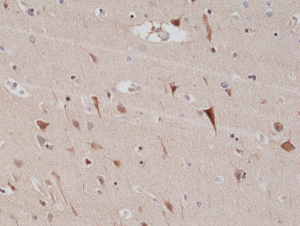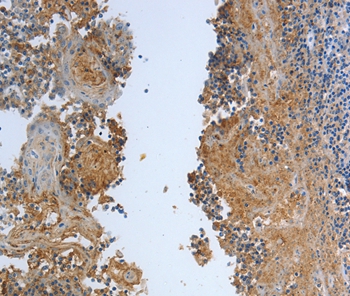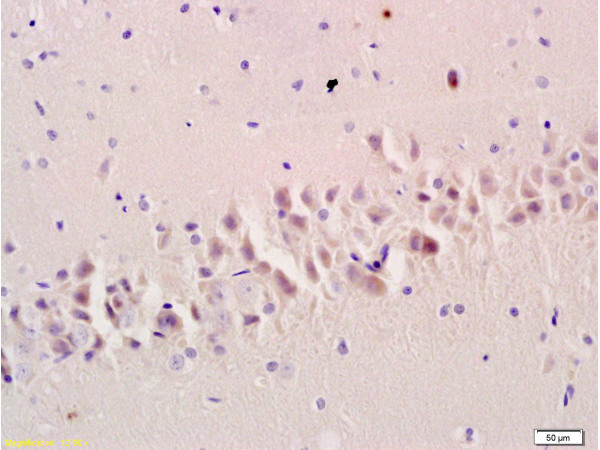
Immunohistochemical staining of formalin fixed and paraffin embedded human brain tissue sections using Anti-PSD95 Rabbit Monoclonal Antibody (Clone RM288) at a 1:200 dilution.
anti-PSD-95, Rabbit Monoclonal (RM288)
REV-31-1172-00
ApplicationsWestern Blot, ImmunoHistoChemistry
Product group Antibodies
ReactivityHuman, Mouse
TargetDLG4
Overview
- SupplierRevMAb Biosciences
- Product Nameanti-PSD-95, Rabbit Monoclonal (RM288)
- Delivery Days Customer10
- ApplicationsWestern Blot, ImmunoHistoChemistry
- CertificationResearch Use Only
- ClonalityMonoclonal
- Clone IDRM288
- Gene ID1742
- Target nameDLG4
- Target descriptiondiscs large MAGUK scaffold protein 4
- Target synonymsMRD62, PSD95, SAP-90, SAP90, disks large homolog 4, Tax interaction protein 15, discs large homolog 4, post-synaptic density protein 95, synapse-associated protein 90
- HostRabbit
- IsotypeIgG
- Protein IDP78352
- Protein NameDisks large homolog 4
- Scientific DescriptionPSD-95 is a member of proteins located at a specialized postsynaptic membrane region, called the postsynaptic density (PSD). PSD-95 is the most abundant scaffold protein specifically enriched in the PSD. It contains three PDZ domains, an SH3 domain and a guanylate kinase (GuK)-like domain. Through its PDZ domains, PSD-95 assembles various synaptic components at the PSD including intracellular signaling molecules (e.g. SynGAP and kalirin-7), ion channels (e.g. stargazin/AMPA receptors [AMPARs] and NMDA receptors) and cell adhesion molecules (e.g. neuroligin). PSD-95 plays a primary role in synaptic development and maturation and is regulated by palmitoylation at its N-terminal cysteine residues leading to its postsynaptic targeting. Palmitoylation of PSD-95 is triggered by DHHC2, a plasma membrane-inserted palmitoylating enzyme. Palmitoylated PSD-95 is almost exclusively localized at excitatory synapses in neurons. - Recombinant Antibody. This antibody reacts to human and mouse PSD95. It may also react to rat PSD95, as predicted by immunogen homology. Applications: WB, IHC. Source: Rabbit. Liquid. 50% Glycerol/PBS with 1% BSA and 0.09% sodium azide. PSD-95 is a member of proteins located at a specialized postsynaptic membrane region, called the postsynaptic density (PSD). PSD-95 is the most abundant scaffold protein specifically enriched in the PSD. It contains three PDZ domains, an SH3 domain and a guanylate kinase (GuK)-like domain. Through its PDZ domains, PSD-95 assembles various synaptic components at the PSD including intracellular signaling molecules (e.g. SynGAP and kalirin-7), ion channels (e.g. stargazin/AMPA receptors [AMPARs] and NMDA receptors) and cell adhesion molecules (e.g. neuroligin). PSD-95 plays a primary role in synaptic development and maturation and is regulated by palmitoylation at its N-terminal cysteine residues leading to its postsynaptic targeting. Palmitoylation of PSD-95 is triggered by DHHC2, a plasma membrane-inserted palmitoylating enzyme. Palmitoylated PSD-95 is almost exclusively localized at excitatory synapses in neurons.
- ReactivityHuman, Mouse
- Storage Instruction-20°C
- UNSPSC12352203






